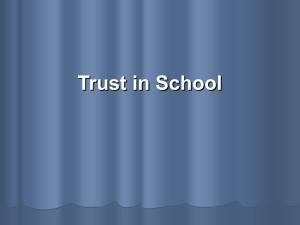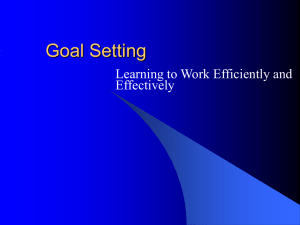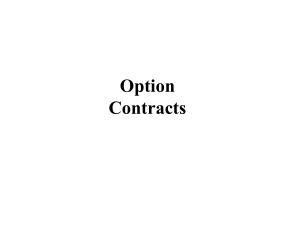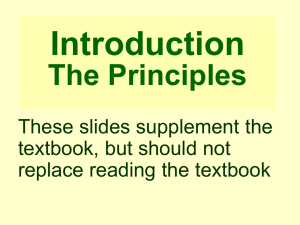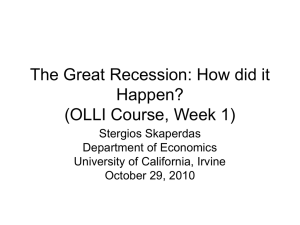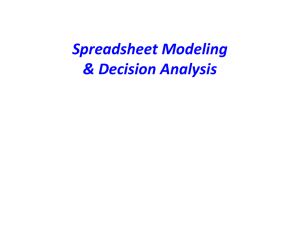Chapter_9_-powerpoint
advertisement
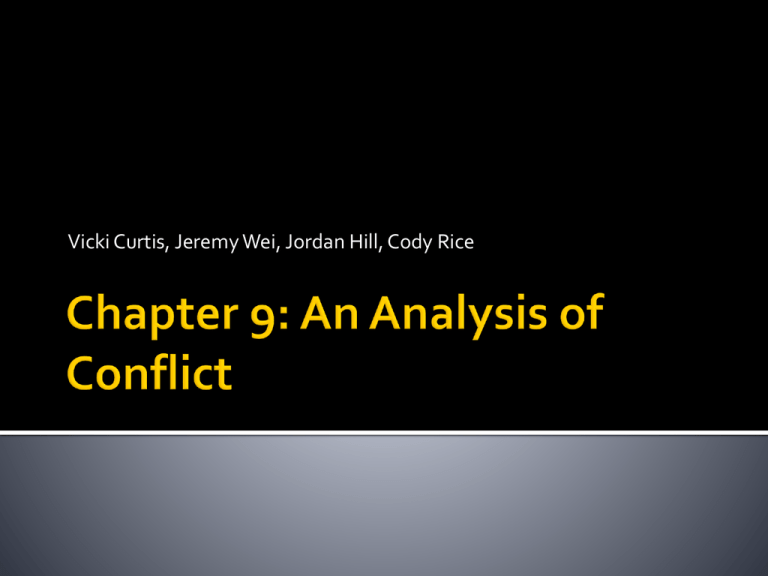
Vicki Curtis, Jeremy Wei, Jordan Hill, Cody Rice Introduction to Game Theory Non-Cooperative Game Theory Cooperative Game Theory Implications Holmstrom Reconciliation and Conclusion of Chapter 9 Article: Project Earnings Manipulation: An Ethics Case Based on Agency Theory Underlies many current issues in financial accounting theory Models the interaction of two or more players Occurs in the presence of uncertainty and information asymmetry Game theory is more complex than decision theory and the theory of investment The number of players lies “in between” the number in single person decision theory and in markets. In game theory the number of players is greater than one, but is sufficiently small Many different types of games Classified as cooperative or non-cooperative Cooperative game: parties can enter into a binding agreement. Non-cooperative game: an oligolopolistic industry is an example of a non-cooperative game Constituencies of financial statement users Both parties are aware of the other parties reactions in making their decisions Game theory provides a framework for studying the conflict and predicting what decisions the other party will make Classified as a non-cooperative game RD Since both parties know the other parties strategy this is the only strategy pair that each party will be satisfied with his or her decision. This is called the Nash Equilibrium Nash equilibrium suggests it is difficult to make longer-run conclusions from a singleperiod game Single-period is repeated from an indefinite number of periods Government intervention may change the pay-offs to enforce co-operation No The manager will anticipate the investor’s move to sell at period 5 and as a result will distort at period 4. At this point the manager’s payoff will be 200 rather than the 180 he would receive at period 5. Further to the strategy just explained, the game would continue to unravel as both parties anticipate that the other will end the game on their next turn. This goes all the way back to period 1 where the investor will end the game and players receive the Nash equilibrium pay-offs of the single-period game Involves two or more parties co-operating via binding contract Two types of contracts Employment contracts Lending contracts A branch of game theory that studies the design of contracts to motivate a rational agent to act on behalf of a principal when the agent’s interest would otherwise conflict with those of a principal Main concept is principal vs. agent Game Inc. Owner Maximize their payoff (expected cash flow) ▪ First Best: option with highest pay off ▪ Second Best: option with second highest pay off Manager Maximize their utility (expected benefit) Agency Cost Difference between first best and second best Must minimize this cost Game Inc. is a company that has a single owner and single manager Owner = principal Manager = agent ▪ Manager gets paid $25 per year In this company, there are two possible payouts: Good times (G) = $100 Bad times (B) = $55 Payout Represents the receipt of cash generated by the company Measured by expected cashflows ▪ E(cf) = p(x1) + p(x2)....p(xz) Utility Represents the net benefit for the manager’s effort Measured by square root of monetary compensation net of disutility ▪ E(u) = √(x) - D The manager has two choices Work hard Slack off If the manager works hard: Probability of G = 0.6 Probability of B = 0.4 If the manager slacks off: Probability of G = 0.4 Probability of B = 0.6 Work Hard (W) Slack Off (S) Pay-off Probability Pay-off Probability Good Times (G) $100 0.6 $100 0.4 Bad Times (B) $55 0.4 $55 0.6 Managerial effort can increase the odds of a high payout (i.e. $100) Therefore a rational owner would want the manager to work hard Can be illustrated by their expected payoff: E(G) = 0.6(100-25) + 0.4 (55-25) = 57 E(B) = 0.4(100-25) + 0.4 (100-25) = 48 A rational manager wants to maximize their utility Remember: Greater effort results in greater cost, therefore greater compensation must offset this EU(W) = √25 – 2 = 3 EU (S) = √25 – 1.71 = 3.29 Manager will choose to slack off Moral Hazard Manager will choose to slack off despite the owner wanting them to work hard Owner must find a way to overcome this moral hazard 1. 2. 3. 4. 5. Put up with manager slacking off Direct monitoring of managerial performance Indirect monitoring of managerial performance Rent company to manager Share pay off with manager Remember: Must find the option that results in the highest pay off Owner allows manager to slack off Evidently not ideal as this will not result in the highest expected pay off Agency Cost = 57 – 48 = 9 Owner observes the actions of the manager to ensure they are working hard Thus guarantee manager works hard (W) Ideally, the best option as this guarantees the highest pay off (G) Realistically, impossible as owners do not have the time or resources to do this Results in an information asymmetry between manager and owner (moral hazard) Owner were to determine the manager’s effort based on the ending payoff If pay off = B, owner would know manager slacked off Realistically impossible since there are external factors that could effect payoff E.g. Recession, natural disaster, etc... Owner gives up the risks and rewards of Game Inc. in exchange for a guaranteed pay off of $51 Manager will now be willing to work hard (W) since they take on risks and rewards Not ideal since the pay off is below ideal Agency Cost = 57 – 51 = 6 Based on a performance measure, the owner could determine the pay of a manager Net income is common measure By sharing the risks, the manager becomes risk averse (rather than risk neutral) Results in manager wanting to work hard This is clearly most ideal option! Net Income does not represent pay off, it is an indicator of potential payoff While it is the best indicator, it is not perfect Imperfection due to: Estimations Accruals As a result, there is a risk of noisy (imperfect) net income Due to imperfect net income, the probabilities are now updated: If payoff is $100 – net income will be ▪ 80% chance of $115 (correct) ▪ 20% chance of $40 (incorrect) If payoff is $55 – net income will be ▪ 20% chance of $115 (incorrect) ▪ 80% chance of $40 (correct) EU(W) = 0.6(0.8 √(0.3237 x 115) + 0.2 √(0.3237 x 40) + 0.4(0.2 √(0.3237 x 115) + 0.2 √(0.3237x40)) – 2 = 3 EU(S) = 0.4(0.8 √(0.3237 x 115) + 0.2 √(0.3237 x 40) + 0.6(0.2 √(0.3237 x 115) + 0.2 √(0.3237x40)) – 1.71 = 2.9896 E(W) = 0.6(0.8(100-0.3237 x 115)) + 0.2(100 – (0.3237 x 40)) + 0.4(0.2(55-(0.3237x115) + 0.8(0.3237x40)) = 55.456 Agency Cost = 57 – 55.456 = 1.544 Appears as though we have minimized the agency costs due to the moral hazard If accountants can improve net income to better reflect pay off, imperfections can be reduced Results in reduced compensation risk Paying a manager for a high net income when the actual payoff will be low Example of Game Inc. assumed managers have no control over reporting process Reality is that they do (positive accounting theory) What does this mean? Managers are able to manipulate numbers without the owner knowing Through regulations like GAAP, this can prevent absolute earnings management Let’s now assume Net income is a range ▪ 115 = 111 – 116 ▪ 40 = 36 – 41 EU(W) = 0.6(0.8 √(0.3193x116) + 0.2 √(0.3193 x 41)) + 0.4(0.2 √(0.3193x116) + 0.8 √(0.3193 x 41) – 2 = 3 EU(S) = 0.4(0.8 √(0.3193x116) + 0.2 √(0.3193 x 41)) + 0.6(0.2 √(0.3193x116) + 0.8 √(0.3193 x 41) – 1.71 = 2.99 As you can see, the owner will work hard E(W) = 0.6(0.8 (100- (0.3193 x 116) + 0.2 (100 (0.3193 x 41)) + 0.4(0.2 (55- (0.3193 x 116) + 0.8 (40 -(0.3193 x 41)) = 55.4981 Agency Cost – 57 – 55.4981 = 1.5091 Evidently there will always be a moral hazard between managers and owners Given the restrictions of owners ability to influence the managerial actions, there is an information asymmetry Through accounting regulations (i.e. GAAP), accountants can influence managerial actions Thus, reducing agency cost! Agency cost illustrates the role of accountants in financial reporting Role 1: Create accounting policies that can increase the accuracy of net income as a predictor Role 2: Create regulations that reduce a managers ability to manipulate net income Principal cannot observe actions of manager Moral hazard problem Information Asymmetry Conflict of interest Divergence of Interests Raising interest rates acts as a deterrent for managers Reduce the cost of borrowing capital Limit dividends Limit additional borrowing Recall: Agency theory Compensate the managers as a part of the Holmström Agency Model Rigidity of Contracts Contributed to the agency model Use of simultaneous performance measures Net income Share price performance Performance Measure Characteristics Sensitivity Manager effort Understand manager motivation Reserve Recognition Accounting Precision A reciprocal of the variance of the noise How good is it predicting payoff? Ensure both measures are: Jointly observable Relates to net income Reveals more information Managers have no control over share price External factors influence the price performance Management’s actions may not be directly reflected in share prices Assume an efficient Assumption: Legal system has authority to enforce contract provisions without cost and resolve disputes Once contracts are signed: Difficult to change (costly) May continue over a long period of time Factors to consider: Anticipation of contingencies “Incomplete” contracts Renegotiation Manager’s remuneration depends on net income and lending contracts Contract covenants affect the manager’s actions Managers still have the ability to manipulate accounting policies irrespective of the effect on decision usefulness to investors Investor reaction and cost of capital is affected by accounting policy choice regardless of impact on cash flow Means of communicating inside information to the public. Conflict theories Net income’s role in motivation and monitoring manager performance Net income competes with other performance measures Earnings management allows shirking – lower payoffs $2 million of R&D costs to allocate Could cause project she manages incur a loss Will lose her bonus Could allocate to other projects Upper management pressure to meet growth targets How much cost should be charged to unfinished products if K(3) is to a) break even? What is the impact on Sue’s bonus? b) earn a normal level of profit? Which scenario does she have more incentive to choose, why? Contract Costs Identifiable with or allocable to specific contracts Direct materials Direct labour Overhead Already incurred Expected costs to complete Does Accounting for Contracts provide useful guidelines in this situation? Is the decision material? Does it matter if it is material? Impact on stakeholders Who are the stakeholders? What are their rights and expectations? What is Sue’s obligation to each? Decision Time! Imagine you are Sue Davies, how would you allocate the remaining $2 million of R&D? Why?
